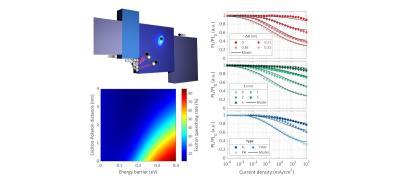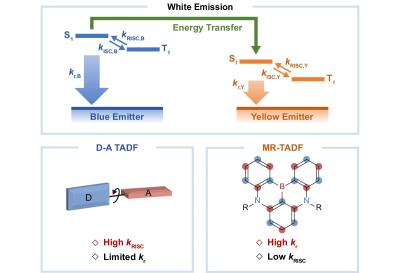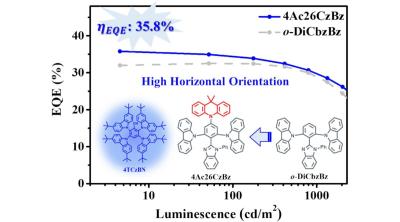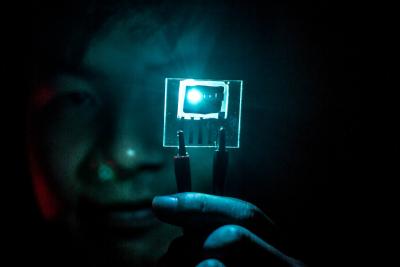TADF OLED emitters, introduction and market status
TADF OLED emitters, or Thermally Activated Delayed Fluorescence, is a relatively new class of OLED emitter materials that promise efficient and long-lifetime performance without any heavy metals. TADF research started in earnest in 2012, and the first TADF emitters reached commercial status at the end of 2019.

There are currently three main challenges with OLED emitters that TADF aims to solve - an efficient and long-lasting blue color emitter, low cost alternatives current red and green emitters and the development of soluble OLEDs that can be deposited using low cost ink-jet printing or other "wet" methods.
TADF is being developed by several companies. Japan-based Kyulux was established to commercialize Prof. Adachi's HyperFluoresence technology, which combines two emitter systems, TADF and Fluorescence. While a blue HyperFluoresence emitter is not here yet, in late 2019 Kyulux and Wisechip brought to market the first OLED with a yellow HF emitter. Kyulux believes it will be able to commercialize its AMOLED Hyperfluorescence materials by 2025.
Another company involved with TADF development was Germany-based Cynora. In 2022, Cynora was acquired by Samsung. Other companies include Noctiluca, and beeOLED.
Idemitsu Kosan also considers TADF as one of the key OLED technologies and intends to focus on TADF in the future. In late 2019 Idemitsu together with Toray announced the world's most efficient red OLED emitter - based on Idemitsu's TADF/HF material. UDC has been recently awarded a patent on TADF materials, although the company says that TADF is not in its focus.
The EU launched two TADF related collaborative research projects to focus on TADF emitters, Project HyperOLED and the 2015 project Phebe.
Noctiluca signs a JDA with TCL CSoT's Juhua to develop TADF emitters, upgrades to the main stock exchange in Poland
Poland-based OLED material developer Noctiluca announced that it has signed a joint development agreement (JDA) with a subsidiary of the world’s second-largest TV manufacturer and a leader in display technology from China, focused on industrializing printed OLED technologies. This is likely to be TCL CSoT's Juhua printing subsidiary. TCL CSoT recently started to produced inkjet printed OLEDs.
Noctiluca and TCL CSoT will work together to adopt Noctiluca's proprietary chemical compound into TCL's OLED displays. The company does not detail what kind of materials will be tested in this agreement. The company develops both TADF/HF OLED emitters and also EIL materials for blue OLED emission.
BNTPA molecule shows promise for long-lasting high-efficiency deep red MR-TADF emitters
Researchers from the University of Science and Technology of China (USTC and the Beijing Information Science and Technology University (BISTU), have developed a new strategy for the design of deep red MR-TADF OLED emitters, that offers high efficiency, good color emission and long lifetimes.
The researchers report they have developed a new deep red (0.657,0343 CIE) OLED emitter material that achieves high efficiency, over 43% EQE, which they say is the most efficient MR-TADF red emitter.
Rigidly planar charge-transfer molecules may unlock long-lasting TADF OLED emission
Researchers from Durham University have used a unique molecule to create TADF emitters with better triplet harvesting, and thus extended lifetime. The fused indolocarbazole-phthalimide molecules offer rigidly planar charge-transfer and can maintain their stability and efficiency over time, even in high-stress conditions.
The researchers say that the new molecules break all our current ideas about excited states in OLED emitters and the researchers developed a new model linking molecular bonding patterns leading to the breaking of molecular pi-conjugation in the excited state.
Kyulux signs an agreement with Nippon Soda to build a TADF materials mass production facility
Kyulux announced that it has singed a capital and business alliance agreement with Nippon Soda, to establish a mass production system for TADF OLED emitter materials. Nippon Soda will take an equity stake in Kyulux and will engage in process development and capital investment toward establishing the mass production system.
This will be the world's first mass production and stable supply system for TADF materials. Kyulux aims to achieve full-scale mass production of its Hyperfluoresence emitter system by 2025, and this will be an important step forward as it will require a stable supply of TADF materials.
Researchers from SNU and Samsung identify a critical mechanism in OLED performance degradation, and use the knowledge to dramatically improve OLED efficiency and lifetime
Researchers from Seoul National University (SNU), in collaboration from colleagues from Samsung's SAIT institute, have identified a critical mechanism behind the performance degradation of OLED devices, the interfacial exciton-polaron quenching mechanism.
The researches have theoretically proposed a mechanism where excitons in the light-emitting layer are quenched by the accumulated charges at the interface. They followed with with experiments that have independently observed this phenomenon, identifying three key factors: interfacial barrier, exciton-polaron distance, and exciton lifetime.
Researchers combine blue TADF emitters and yellow MR-TADF emitters to create high efficiency and long-lasting white OLED devices
Researchers from Shenzhen University and Wuhan University have designed new white OLED devices that exhibit exceptional power efficiency (over 190 lm/W, 39% EQE) and extended operational lifetime (LT80 446 hours at 1,000 cd/m2).
The new device uses a blue TADF emitter emitter combined with a yellow MR-TADF emitter. The light is a warm white light. The researchers also used the same technique to create a standard white emission device, that still achieves a high EQE of 35.6%, thus further validating the strategy.
Researchers design a highly promising host material for blue TADF OLED devices
Researchers from National Taiwan University, together with colleagues from Yuan Ze University, National Dong Hwa University and Academia Sinica, have developed a very high efficiency blue TADF OLED device, by adopting a favorable horizontal oriented host material.
The researcher designed a new host material (4Ac26CzBz) that is made from acridan and carbazole moieties linked to a benzimidazole core. The host material exhibits a wide optical gap (Eg) and high triplet energy (T1) of 3.3 and 3.0 eV, respectively. The researchers used 4TCzBN as the blue-light TADF dopant, and report a remarkably high device external quantum efficiency of 35.8 % (59.8 cd/A and 62.8 lm/W) and a low turn-on voltage (<3 eV). The device features with significant suppression of the efficiency roll-off, maintaining a high efficiency of 29.7 % as luminance at 1000 cd/m2.
BOE shows a TADF-sensitized Tandem AMOLED device prototype
During the company's Innovation Partner Conference, BOE demonstrated a new 6.55" OLED panel prototype that utilizes TADF-sensitized materials and a tandem stack architecture. The company says that the TADF materials offer significantly improved color gamut, and it achieve 95% BT.2020 coverage, this in addition to the high power efficiency and long lifetime.
It is our understanding that BOE's TADF-Sensitized material platform combines a deep green Hyperfluorescence emitter and a standard deep-red phosphorescence material. The blue emitter is likely a standard fluorescence bluet emitter.
Samsung Display: we develop blue OLED emitter technologies, both PHOLED and TADF based
Samsung Display's Lee Chang-hee, VP and head of SDC's research center, gave a talk during K-Display 2024, and updated that Samsung is progressing towards a next-generation blue OLED emitter technology in two tracks.
SDC is working with Universal Display, to adopt the company's blue PHOLED system. This is progressing, but SDC says that the pace is slow - indeed we heard from UDC lately that the introduction of a commercial material will take longer than expected.
Next generation OLED emitter development - industry update
OLED emitter materials are the heart of the OLED device, and the materials that make the most impact on the performance of the OLED display. Most OLED displays utilize red, green and blue emitters.
The efficiency of the current state-of-the-art commercial red and green OLED emitters is excellent - it is in fact close to 100% internal quantum efficiency (IQE) which means that you cannot improve much on the efficiency of the emitter itself (there's still work to be done on getting the light out of the device). Blue OLED emission is a completely different story - current commercial blue emitters suffer from very low efficiency, around 25%. This means that three quarters of the energy goes to waste. Changing to a 100% IQE blue emitter could end up improving the total display efficiency by 20-30%.
Pagination
- Page 1
- Next page











